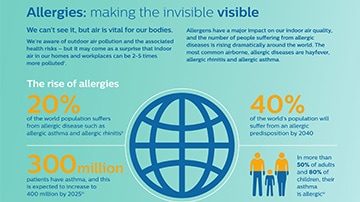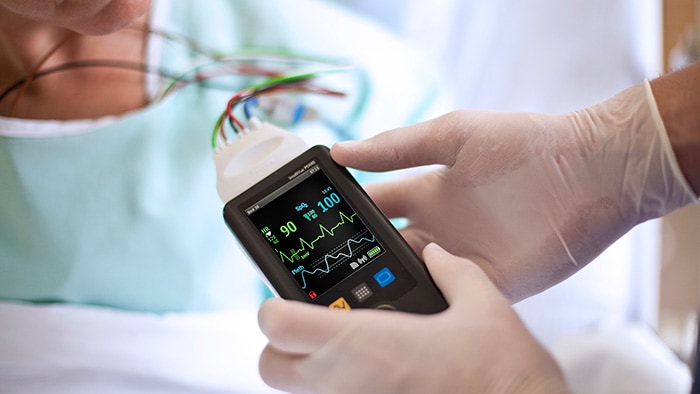Apr 03, 2017
Take control of the air you breathe at home this World Allergy Week
Philips is calling on people to get smart and take control of the quality of the indoor air they breathe, every day.
Kuala Lumpur, Malaysia – Whilst we’re increasingly aware of rising levels of outdoor air pollution and the associated health risks, it may come as a surprise that the indoor air we breathe at home or in the workplace can be 2-5 times more polluted1. Poor quality indoor air is known to aggravate the symptoms of allergic diseases. So, this World Allergy Week – an annual initiative of the World Allergy Organisation (WAO) that raises awareness of allergic disease and related disorders – Philips is calling for people to get smart and take control of the quality of the indoor air they breathe, every day. One of the major factors influencing indoor air quality is the presence of allergens, such as dust, pollen, dust mites, mold spores and pet dander. Among the most prevalent chronic diseases, the number of people affected by allergies is increasing. In fact, the World Health Organisation estimates that over 20 per cent of the world population suffers from allergic disease, such as hayfever, allergic asthma and allergic rhinitis2. Muhammad Ali Jaleel, Country Manager for Philips Malaysia said, “At Philips, we want people to be healthy, live well and enjoy life. Our home should be our sanctuary, and has a crucial part to play in helping us to take control and ownership of our health. Within this context, being able to breathe clean air at home is fundamental to helping people live more healthily. This is why we work in partnership with globally renowned experts – such as AHAM, ECARF and AirMid – and leverage our leading expertise in respiratory health to design humidifiers, purifiers and combi products that can help to reduce exposure to airborne allergens.” For those that suffer from allergies, the impact on their quality of life can be significant. 87 per cent of people say their allergic rhinitis affects their sleep, and a worrying 92 per cent of people admit their allergy symptoms affect their work, school or daily routine3. It is estimated that symptoms like a blocked nose and fatigue result into a loss of productivity ranging from 11 to 40 per cent4.
We can improve the air we breathe
People across the world are looking for new ways to take greater control of their personal health and well-being. We pay a lot of attention to what we eat and drink each day, but little thought is given to the air we breathe – and the quality of the air we breathe has an essential part to play in our long term health. While allergy sufferers are powerless to control the quality of outdoor air, they can improve their indoor air at home and monitor outdoor allergen levels. Philips’ aim is to help everyone to improve the quality of the air they breathe indoors by helping to remove many of the irritants and allergens that can trigger the symptoms of allergies. The VitaShield Intelligent Purification System (IPS) is a feature available in our air purifiers (AC4081, AC4014, AC2887, AC3256 and AC4012) and has proven effectively filters out pollutants with size bigger than 0.02 Microns. These pollutants include ultrafine particles, allergens, bacteria and even viruses. Every home and individual is unique, so the VitaShield IPS offers a comprehensive range of advanced filters optimized for different environments and needs. Philips VitaShield IPS filters use state-of-the-art filter grades to trap and collect a wide range of indoor air contaminants. [1]Actual values were indoor/outdoor ratios of 1.62–6.37 for the summer months and 2.05–10.99 for the winter months. Text and Figure from: T. Salthammer Angewandte Chemie Int. Ed. 52, (2013), 3320; [2] http://www.who.int/gard/news_events/1-3.GARD-06-07-K1.pdf?ua=1 [3]Allergy UK, http://www.allergyuk.org/downloads/Corporate%20/final-haymax-report-2016-part-1.pdf [4]Walker S et al (2007). Seasonal allergic rhinitis is associated with a detrimental effect on examination performance in United Kingdom teenagers: case-control study. Journal of Allergy and Clinical Immunology 120(2); 381-387
At Philips, we want people to be healthy, live well and enjoy life. Our home should be our sanctuary, and has a crucial part to play in helping us to take control and ownership of our health. Within this context, being able to breathe clean air at home is fundamental to helping people live more healthily. This is why we work in partnership with globally renowned experts – such as AHAM, ECARF and AirMid – and leverage our leading expertise in respiratory health to design humidifiers, purifiers and combi products that can help to reduce exposure to airborne allergens
Muhammad Ali Jaleel
Country Manager for Philips Malaysia
About Royal Philips
Royal Philips (NYSE: PHG, AEX: PHIA) is a leading health technology company focused on improving people's health and enabling better outcomes across the health continuum from healthy living and prevention, to diagnosis, treatment and home care. Philips leverages advanced technology and deep clinical and consumer insights to deliver integrated solutions. Headquartered in the Netherlands, the company is a leader in diagnostic imaging, image-guided therapy, patient monitoring and health informatics, as well as in consumer health and home care. Philips' health technology portfolio generated 2016 sales of EUR 17.4 billion and employs approximately 70,000 employees with sales and services in more than 100 countries. News about Philips can be found at www.philips.com/newscenter.
Topics
Contacts

D. Punitha Grace
Brand & Corporate Communications Manager Philips Malaysia Tel: +603 79657702









